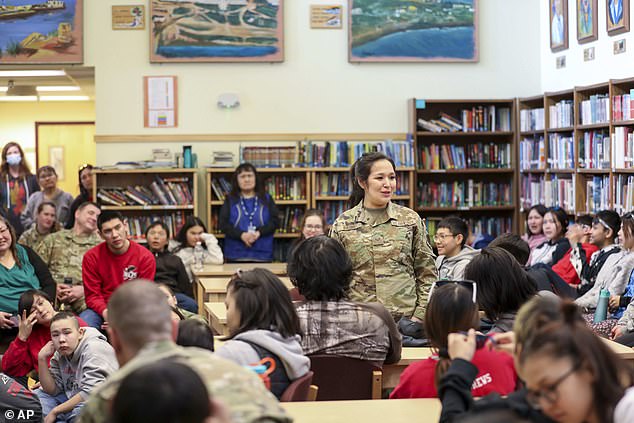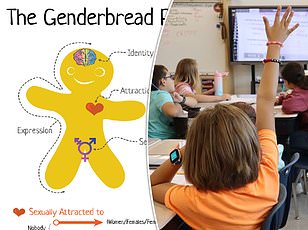America's worst public schools REVEALED: Parents in this Sun Belt state on notice
- New Mexico, Oklahoma, Arizona, Alaska, and Louisiana, ranked worst
- Massachusetts, Connecticut, Maryland, New Jersey and Wisconsin scored best
- READ MORE: Teachers issue BLEAK warning about kids' performance in schools
New Mexico has ranked as having the worst public schools in the country, a new survey shows.
The Sun Belt state's schools rate much worse than those elsewhere thanks to low student graduation rates, weak funding, poor safety, large class sizes, and a lack of good teachers.
Oklahoma, Arizona, Alaska, and Louisiana rounded out the bottom five public school systems, research by WalletHub shows.
Parents looking for decent tax-funded schools may need to head to the US Northeast.
Massachusetts ranked as having the best schools in the country.

Fifth grade students at a computer lab in a church-run school in New Mexico, which has among the worst public schools in the country

Researchers revealed which states have the best and worst public school systems
It was followed by Connecticut, Maryland, New Jersey and Wisconsin.
Cassandra Happe, an analyst for the personal finance website, said much of the difference comes down to how much money states spend on their students.
'Getting enough funding is essential for a productive school system, but simply having more money doesn't guarantee success,' said Happe.

Cassandra Happe says funding schools is key
Schools districts still need to spend money wisely and focus on the 'quality of educators, other professionals and the curriculum.'
The study comes in the wake of pandemic-era school closures that left sent math and literacy levels tumbling, even when they did little to prevent the spread of Covid-19.
It also comes as millions of Americans weigh whether to relocate to another part of the country — a flow that sees many opt for lower tax states in the South that in many cases have weaker public school systems.
WalletHub researchers examined data from the US Census Bureau, the Department of Education, the National Center for Education Statistics and other sources.
This included graduation rates, dropout rates, test scores, as well as measures of safety, such as the prevalence of bullying and the number of students who take a gun to class.
New Mexico scored by far the lowest in the country — a problem that is well known to state education chiefs.
State Education Secretary Arsenio Romero recently complained that his school districts were struggling to hire teachers as educators fled the profession in droves.

Students walk on campus at the Santa Fe Indian School in New Mexico, where districts struggle with a crippling shortage of teachers

New Mexico State Education Secretary Arsenio Romero says staffing schools is a problem

A graduation ceremony for students in Holden, Louisiana, which has one of the nation's weakest public schools in the country
A staggering 59 percent of New Mexico's young students, those aged three to four, do not see the inside of a classroom, according to the Annie E. Casey Foundation.
Nearly four fifths of the state's fourth graders cannot read, while a staggering 87 percent of eighth graders are not proficient in math, the foundation says.
Analyst often point to student demographics, which is about 62 percent Hispanic, leading to communication issues in many classes.
The system was thrown into further disarray in April, when dozens of school districts sued the education department over its plans to introduce a controversial 180-day school calendar rule.
The department did not answer DailyMail.com's request for a comment.
Researchers ranked Oklahoma as having the second-worst public schools in the country.
The Sooner State is currently embroiled in a controversy over a new rule that schools begin incorporating the Bible into lessons.
Republican state Superintendent Ryan Walters said the rule for all public school students aged about 11-18 was compulsory.
It came on the heels of a similar controversy in Louisiana — which has the fifth worst schools in the country — and where a new law directs all public schools to display the Ten Commandments.
At the other end of the scale, Massachusetts ranked as having the best public schools in the US, thanks in part to its high math and reading scores.
Researchers also highlighted the safety of schools in the Bay State, where drugs and schoolyard fights are uncommon.
Connecticut ranked second thanks to its excellent test scores and the large number of teachers, compared to student numbers.
The report comes as parents and teachers are increasingly alarmed about slipping standards and low attendance at the nation's schools as they struggle to reverse effects of the pandemic.

A service member speaks with students at a school in Alaska, one of the lowest performing states in the country

Seventh grade teacher @qbthedon (pictured) asked parents: 'Why don't y'all know that your kids aren't performing on their grade level?'
America's schools have started to make progress toward getting students back on track.
Nationally, students made up one-third of their pandemic losses in math during the past school year and one-quarter of the losses in reading, says the Education Recovery Scorecard, an analysis of test scores by researchers at Harvard and Stanford.
But improvement has been slow and uneven across geography and economic status, with millions of students — often those from marginalized groups — making up little or no ground.
States have used some money from the historic $190 billion in federal pandemic relief to help students catch up, but that money runs out later this year.
'The recovery is not finished, and it won't be finished without state action,' Thomas Kane, a Harvard economist, told AP last month.
'States need to start planning for what they're going to do when the federal money runs out.'
Against thie backdrop, teachers have taken to social media to warn that kids are falling behind with their basic reading and writing skills - and claim parents are totally ignorant to the alarming situation.
In a TikTok video, which has been viewed more than five million times, seventh grade teacher @qbthedon asked parents: 'Why don't y'all know that your kids aren't performing on their grade level?'
'I teach seventh grade, they are still performing on a fourth-grade level,' he complained.
'We all know that the world is behind, you know, globally,' he acknowledged. 'Because of the pandemic and stuff. But I don't understand why they are not stressing to y'all how bad it is.'
The teacher, from Atlanta, Georgia, claimed he can 'put as many zeros in this grade' as he wants to, but the kids will still be moved up to the next grade.
'Ain't nobody talking about that,' he said incredulously.
'These [are] our future leaders, our future doctors, our future nurses - our future,' he said desperately. 'Please!'





































































































































































































































































































































































